This post may contain affiliate links. That means if you click and buy, I may receive a small commission. Please read my full disclosure policy for details.
HYDROPONIC GARDENS Training & Pruning Vining Crops
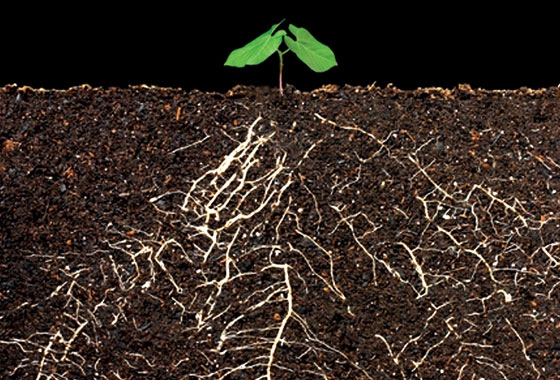
In a traditional soil-grown garden, plants put down roots deep and wide as they search for necessary food and moisture. This anchors the plant securely and provides a sturdy base.
Plants grown in the hydroponic method have a much smaller root ball, as they don’t have to spread out looking for nourishment. It’s delivered right to them!
So the larger and taller vining hydroponic plants must be supported as they grow tall towards the light.
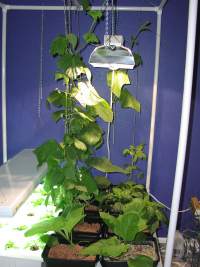
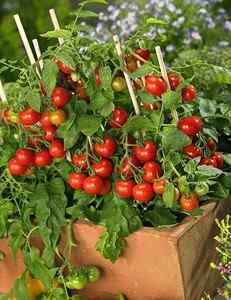
When you first start out, or are restricted by a small unit, we suggest you start with smaller varieties, like Tiny Tim or patio tomatoes and bush beans.
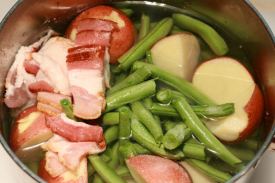
But once you get a little experience under your belt, and find more room, by all means go for the vining plants. Nothing like a pot of fresh stewed Kentucky Wonder green beans!
Hydroponic Gardens: Grow UP
Tomatoes, cucumbers, pole beans and peas, squash and melons all must be trained up or they will quickly sprawl and take over your entire hydroponic gardens. Grow your lettuce and herbs separate from the tall vining crops, or harvest quick-growing lettuces before they are overshadowed by the tall vines.
You can increase the amount of veggies you produce by intercropping— by alternating tall and short plants in the grow bed. Two bushy tomato plants planted right together get in each other’s way. Put a bunch of leaf lettuce or a basil bush between them.
You can harvest an amazing amount of produce from one square foot of garden bed by growing UP. The vining plants must be trained and supported by stakes, strings or trellises.
And they must be limited in growth to the max height of the light system. So it’s a little tricky, but well worth learning how. The weight of these plants must be supported by clipping the vines to strings or wires attached to the ceiling or plant bed frame.
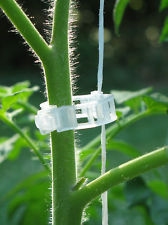 |
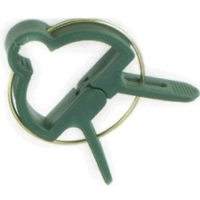 |
They sell plastic vine clips to attach the vines to the string, but we just use thin garden wire and form a loop loosely around the stems to support it as it grows up.
The vine clips do have the advantage of not cutting into the stem. They are cheap and widely available, as pictured above.
Hydroponic Gardens: Vining Guide
Here are some quick tips on training and supporting different types of plants:
- Peppers: Bush variety peppers can grow three feet tall and may need support either with a stake or string. They can be very weak at the root ball and fall over if not supported.
- Cucumbers: Definitely need training. Support them with string tied up to an overhead hook or framework. You can actually wrap the string around the main stem as it grows, or use plastic vine clips.
- Green beans: Need no help at all, they support themselves by clinging with tendrils. You may want to eliminate many of the tendrils, as they can wrap around leaves and stems and choke them.
- Tomatoes: Train your tomatoes to a single stem straight up, pruning off any secondary shoots. This keeps the plant from getting too bushy. Use plastic vine clips to hold the tomato to the string or stake.A cluster of ripening tomatoes can be very heavy and so you may want to support the clusters with a “tomato hook” or “truss”.
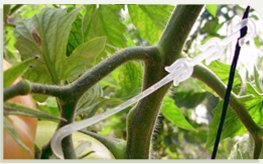
Read more about our “Favorite Fruit” here: Growing Hydroponic Tomatoes
Hydroponic Gardens: Get out the scissors!
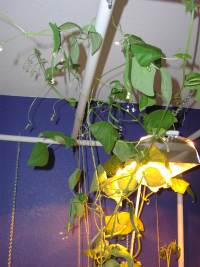
I know you may be reluctant to do surgery on your beautiful hydroponic plants, however smart pruning keeps everything under control and forces the plant to spend more energy on making fruit than reaching out with foliage.
Don’t let the tops of your plants get too far away from the root system.
Hydroponic plants will grow larger than soil-grown ones, and will go
crazy if you let them. Sometimes I get up in the morning, check on my
garden, and it looks like Jack-in-the-beanstalk made a visit while I
slept!
- For bush variety plants, like patio tomatoes, pinch off the tops of the plants at 3 feet or so. Cucumbers, pinch off after 7 sets of leaves.
- For vining tomatoes, it is important to pinch off the suckers as soon as they appear. As the lower leaves turn yellow, strip them from the stem to allow more airflow and light below. When the tomatoes start to cluster, prune each cluster to only 4 to 5 flowers.
|
These are suckers. Pinch them off! |
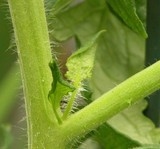 |
- For vining cucumbers, remove the suckers from this plant also and remove all tendrils as they appear. You can also prune lower yellowed leaves as they die off.
- For the other vining varieties of crops, let them go, then prune when they get up too close to the lights.
Pruning is a necessary task to keep the plants manageable, under the lights and transfers the plant’s energy from vining into fruit production.

Reply